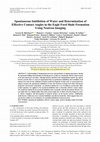Papers by Joanna McFarlane
U.S. Department of Energy Office of Scientific and Technical Information - OSTI OAI, Jun 1, 2018

We demonstrate effects of Cs ions on the melting transition and molecular structure of molten FLi... more We demonstrate effects of Cs ions on the melting transition and molecular structure of molten FLiNaK (a eutectic mixture of LiF-NaF-KF). FLiNaK is a commonly studied multi-component model system, which represents the physical and chemical behavior of fluoride salts for nuclear energy applications. Dissolution of nuclear fuels leads to the formation of fission products directly in the molten salt. Cs is one of the most important fission products, due to its relative abundance, long half life, and potential environmental and health effects. Here, we determine the molecular structure and phase equilibria of dissolved Cs in FLiNaK by a combination of X-ray diffraction, X-ray total scattering, ab initio molecular dynamics calculations, and computational thermodynamics. Although Cs ions have a relatively large size, we did not find significant evidence that they disrupt the existing molecular structure of the liquid. We found good agreement between our simulated and measured structure fac...
Nuclear Engineering and Design, 2021
Abstract Molten salt reactors (MSRs) are being investigated as a possible source of 99Mo for medi... more Abstract Molten salt reactors (MSRs) are being investigated as a possible source of 99Mo for medical uses. This paper describes computational modeling being performed to determine the feasibility for use of several MSR concepts in 99Mo production: the Molten Salt Breeder Reactor (MSBR), the Molten Salt Demonstration Reactor (MSDR), and the Molten Salt Reactor Experiment (MSRE). This modeling is accomplished with SCALE/TRITON using a three-mixture system and estimated removal terms. Results showed that the MSBR, MSDR and MSRE were capable of supplying an estimated 35,800,000, 13,700,000, and 132,000 six-day Ci/week of 99Mo, respectively, which is far more than the global demand. A range of operating parameters has been determined in which each reactor type is expected to have sufficient production capability to meet global demand.
Nuclear Engineering and Design, 2021

Energies, 2021
Bioenergy with carbon capture and storage (BECCS) can sequester atmospheric CO2, while producing ... more Bioenergy with carbon capture and storage (BECCS) can sequester atmospheric CO2, while producing electricity. The CO2 avoidance cost (CAC) is used to calculate the marginal cost of avoided CO2 emissions for BECCS as compared to other established energy technologies. A comparative analysis using four different reference-case power plants for CAC calculations is performed here to evaluate the CO2 avoidance cost of BECCS implementation. Results from this work demonstrate that BECCS can generate electricity at costs competitive with other neutral emissions technologies, while simultaneously removing CO2 from the atmosphere. Approximately 73% of current coal power plants are approaching retirement by the year 2035 in the U.S. After considering CO2 sequestered from the atmosphere and coal power plant CO2 emissions displaced by BECCS, CO2 emissions can be reduced by 1.4 billion tonnes per year in the U.S. alone at a cost of $88 to $116 per tonne of CO2 removed from the atmosphere, for 10% ...
This report reflects technical work which could support future decision making by DOE. No inferen... more This report reflects technical work which could support future decision making by DOE. No inferences should be drawn from this presentation regarding future actions by DOE, which are limited both by the terms of the Standard Contract and Congressional appropriations for the Department to fulfill its obligations under the Nuclear Waste Policy Act including licensing and construction of a spent nuclear fuel repository.

The resurgence of the Molten-Salt Nuclear Reactors (MSR) creates interesting problems in molten-s... more The resurgence of the Molten-Salt Nuclear Reactors (MSR) creates interesting problems in molten-salt chemistry. As MSRs operate, the composition and physical properties of salts change because of fission and corrosion. Since Cr is the principal corrosion product and NaCl is a common constituent, we studied the atomic structure of molten NaCl-CrCl3. We found networks of CrCl3− 6 octahedra and an intermediate-range order with nonmonotonic temperature behavior in a remarkable agreement between measurements and ab initio simulations. Even though the corrosion results in minute quantities of dissolved Cr, the speciation of Cr could lead to changes in molten-salt properties in nuclear and solar salts. In particular, we found a much lower than expected melting temperature and a broad metastable liquid-solid coexistence phase. The availability of Cr isotopes with very different neutron-scattering properties makes Cr an ideal model multi-valent ion for experimental validation of new atomisti...

Bioenergy with carbon capture and sequestration (BECCS) is one strategy to remove CO2 from the at... more Bioenergy with carbon capture and sequestration (BECCS) is one strategy to remove CO2 from the atmosphere. To assess the potential scale and cost of CO2 sequestration from BECCS in the US, this analysis models carbon efficiencies and costs of biomass production, delivery, power generation, and CO2 capture and sequestration in saline formations. The analysis includes two biomass supply scenarios (near-term and long-term), two biomass logistics scenarios (conventional and pelletized), two generation technologies (pulverized combustion and integrated gasification combined cycle), and three cost accounting scenarios (gross cost, net cost after electricity revenues, and net cost after electricity revenues with avoided emissions from conventional power generation). Results show cost Mg-1 CO2 as a function of CO2 sequestered (simulating capture up to 90% of total CO2 sequestration potential) and associated spatial distribution of resources and generation locations for the array of scenario...

International Journal of Analytical Chemistry, 2018
We describe a new approach for high sensitivity and real-time online measurements to monitor the ... more We describe a new approach for high sensitivity and real-time online measurements to monitor the kinetics in the processing of nuclear materials and other chemical reactions. Mid infrared (Mid-IR) quantum cascade laser (QCL) high-resolution spectroscopy was used for rapid and continuous sampling of nitrates in aqueous and organic reactive systems, using pattern recognition analysis and high sensitivity to detect and identify chemical species. In this standoff or off-set method, the collection of a sample for analysis is not required. To perform the analysis, a flow cell was used for in situ sampling of a liquid slipstream. A prototype was designed based on attenuated total reflection (ATR) coupled with the QCL beam to detect and identify chemical changes and be deployed in hostile environments, either radiological or chemical. The limit of detection (LOD) and the limit of quantification (LOQ) at 3σ for hydroxylamine nitrate ranged from 0.3 to 3 and from 3.5 to 10 g·L−1, respectively...

Global Challenges, 2019
still and solar chimney, a solar collector is coupled with a distillation mechanism and the proce... more still and solar chimney, a solar collector is coupled with a distillation mechanism and the process is carried out in one simple cycle. [1] However, in the traditional approach employing direct solar desalination, large-scale deployment is limited by expensive cost and losses in system efficiency, for example, estimated production rate 3-12 kg m −2 per day, [1] where the low efficiency originates from the heat and mass transfer occurring during evaporation and condensation. Hence, indirect solar desalination using photovoltaic (PV) panels and other traditional desalination technologies, for example, distillation and reverse osmosis (RO) have been developed. [2] The conversion efficiency of PV is, however, still low, less than 15% for electricity generation. Recent development of various nanostructured materials, including plasmonic nanoparticles, porous graphene, and ultra-black absorbers composited as an interfacial evaporator, have made it possible to transfer solar-heat directly to generate water vapor with high efficiency. [3-10] In order to achieve efficient solar interfacial evaporation, two key elements are required: 1) efficient solar absorption using blackbody materials and 2) efficient heat management using thermal localization structures as in nanocapillary channels with thermally insulating layers or containers. It has been shown that the engineered interfacial solar evaporators using the two aforementioned aspects can double the light-to-heat conversion efficiency, increasing pure water Solar-thermal driven desalination based on porous carbon materials has promise for fresh water production. Exploration of high-efficiency solar desalination devices has not solved issues for practical application, namely complicated fabrication, cost-effectiveness, and scalability. Here, direct solarthermal carbon distillation (DS-CD) tubular devices are introduced that have a facile fabrication process, are scalable, and use an inexpensive but efficient microporous graphite foam coated with carbon nanoparticle and superhydrophobic materials. The "black" composite foam serving as a solar light absorber heats up salt water effectively to produce fresh water vapor, and the superhydrophobic surface of the foam traps the liquid feed in the device. Two proof-of-principle distillation systems are adopted, i.e., solar still and membrane distillation and the fabricated devices are evaluated for direct solar desalination efficiency. For the solar still, nanoparticle and fluorosilane coatings on the porous surface increase the solar energy absorbance, resulting in a solar-steam generation efficiency of 64% from simulated seawater at 1 sun. The membrane distillation demonstrates excellent vapor production (≈6.6 kg m-2 h-1) with >99.5% salt rejection under simulated 3 sun solar-thermal irradiation. Unlike traditional solar desalination, the adaptable DS-CD can easily be scaled up to larger systems such as high-temperature tubular modules, presenting a promising solution for solar-energy-driven desalination.

Journal of Earth Science, 2017
Understanding of fundamental processes and prediction of optimal parameters during the horizontal... more Understanding of fundamental processes and prediction of optimal parameters during the horizontal drilling and hydraulic fracturing process results in economically effective improvement of oil and natural gas extraction. Although modern analytical and computational models can capture fracture growth, there is a lack of experimental data on spontaneous imbibition and wettability in oil and gas reservoirs for the validation of further model development. In this work, we used neutron imaging to measure the spontaneous imbibition of water into fractures of Eagle Ford shale with known geometries and fracture orientations. An analytical solution for a set of nonlinear second-order differential equations was applied to the measured imbibition data to determine effective contact angles. The analytical solution fit the measured imbibition data reasonably well and determined effective contact angles that were slightly higher than static contact angles due to effects of in-situ changes in velocity, surface roughness, and heterogeneity of mineral surfaces on the fracture surface. Additionally, small fracture widths may have retarded imbibition and affected model fits, which suggests that average fracture widths are not satisfactory for modeling imbibition in natural systems. KEY WORDS: spontaneous imbibition, effective contact angle, neutron imaging, Eagle Ford shale, rock fractures. 0 INTRODUCTION The combination of horizontal drilling and hydraulic fracturing, or fracking, has greatly increased the productivity of oil and natural gas wells, especially in tight gas shales. To
Approved for public release. Distribution is unlimited.

Journal of Natural Gas Science and Engineering, 2016
As the location and accessibility of hydrocarbons is key to understanding and improving the extra... more As the location and accessibility of hydrocarbons is key to understanding and improving the extractability of hydrocarbons in hydraulic fracturing, this study is an attempt to understand how native organics are distributed with respect to pore size to determine the relationship between hydrocarbon chemistry and pore structure in shales.First, selected shale cores from the Eagle Ford and Marcellus formations were subjected to pyrolysis gas chromatography (GC),thermogravimetric analysis, and organic solvent extraction with the resulting effluent analyzed by GC-mass spectrometry (MS). Organics representing the oil and gas fraction (0.1 to 1 wt. %) were observed by GC-MS. For most of the samples, the amount of native organic extracted directly related to the percentage of clay in the shale. The porosity and pore size distribution (0.95 nm to 1.35µm)in the Eagle Ford and Marcellus shales was measured before and after solvent extraction using small angle neutron scattering (SANS). An unconventional method was used to quantify the background from incoherent scattering as the Porod transformation obscures the Bragg peak from the clay minerals. The change in porosity from SANS is indicative of the extraction or breakdown of higher molecular weight bitumen with high
A model for the solubility of organic compounds in produced water was developed and compared with... more A model for the solubility of organic compounds in produced water was developed and compared with the data from the Petroleum Energy Research Forum (PERF) Program 98-04 characterization experiments. * Note that 40 mg·L-1 approaches the daily maximum value for TPH as established by NPDES permits, and is higher than the long-term average level of 29 mg·L-1. * The plot is actually the first response variable versus the first predictor variable, although the transformation back to physical variables will find them closely aligned with organic acid concentration and degree of dissociation, respectively. † Note that this assumption is not valid when considering the highly localized onshore environments. The author has addressed these issues in a paper titled "Offshore Versus Onshore Produced Water Characterization and Models", in










Uploads
Papers by Joanna McFarlane